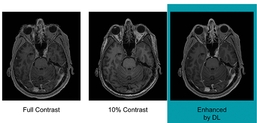Researchers are using artificial intelligence to reduce the dose of a contrast agent that may be left behind in the body after MRI exams, according to a study presented today at RSNA 2018.

Gong
"There is concrete evidence that gadolinium deposits in the brain and body," said study lead author Enhao Gong, PhD, researcher at Stanford University in Stanford, Calif. "While the implications of this are unclear, mitigating potential patient risks while maximizing the clinical value of the MRI exams is imperative."
Dr. Gong and colleagues at Stanford have been studying deep learning as a way to achieve this goal.
To train the deep learning algorithm, the researchers used MR images from 200 patients who had received contrast-enhanced MRI exams for a variety of indications. They collected three sets of images for each patient: pre-contrast scans, done prior to contrast administration and referred to as the zero-dose scans; low-dose scans, acquired after 10 percent of the standard gadolinium dose administration; and full-dose scans, acquired after 100 percent dose administration.
The algorithm learned to approximate the full-dose scans from the zero-dose and low-dose images. Neuroradiologists then evaluated the images for contrast enhancement and overall quality.
Results showed that the image quality was not significantly different between the low-dose, algorithm-enhanced MR images and the full-dose, contrast-enhanced MR images. The initial results also demonstrated the potential for creating the equivalent of full-dose, contrast-enhanced MR images without any contrast agent use.
These findings suggest the method's potential for dramatically reducing gadolinium dose without sacrificing diagnostic quality, according to Dr. Gong.

Example of full-dose, 10 percent low-dose and algorithm-enhanced low-dose.
"Low-dose gadolinium images yield significant untapped clinically useful information that is accessible now by using deep learning and AI," he said.
Now that the researchers have shown that the method is technically possible, they want to study it further in the clinical setting, where Dr. Gong believes it will ultimately find a home. Future research will include evaluation of the algorithm across a broader range of MRI scanners and with different types of contrast agents.
"We're not trying to replace existing imaging technology," Dr. Gong said. "We're trying to improve it and generate more value from the existing information while looking out for the safety of our patients."

